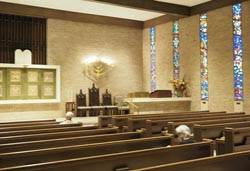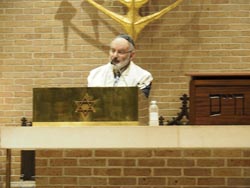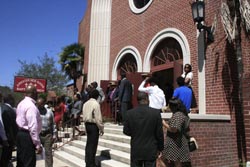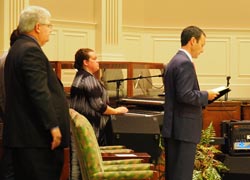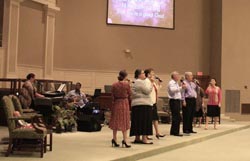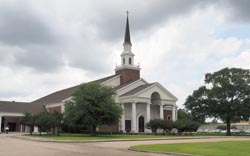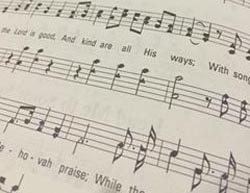Sacred Sounds in Baton Rouge Churches, Synagogues, Temples, and Mosques
By Maureen Loughran

Songleaders: Jewish and Christian Traditions in Baton Rouge
In many congregations, the musical direction is the responsibility of one person, who may sing with the choir, sing as a soloist, play the organ or simply lead congregational singing. Much of their job depends on the kind of music the church or temple uses, and even the role and function of that music in the service.
The Cantor
On a Friday evening in late January, the B'nai Israel congregation gathered for its twice monthly Union Prayer Book Sabbath service. This is one of the most traditional services at this Reform temple. At this particular gathering, children ran up and down the center aisle and played tag among the pews as the members slowly found their desired seats and chatted with the Rabbi. The service began with a blessing and the lighting of the Shabbat candles, which that night was done by the grandmother of many of the children present. That evening, before the service proper, the Rabbi conducted a baby naming ceremony, during which one of the grandchildren would be receiving his Hebrew name. After the ceremony, the Sabbath service began, with the sound of a large pipe organ and the operatic baritone of the cantor leading the congregation in song.
The cantor at this synagogue is Dr. Stephen Rushing. Dr. Rushing is also a professor of music who teaches voice at Southeastern University in Hammond, and he is the music director at First Presbyterian Church in Baton Rouge. While Dr. Rushing did not grow up in the Jewish tradition, he has a lot of experience singing for Jewish services. His experience as a song leader, however, started in the Catholic Church, the church in which he was raised. Singers are usually in high demand as leaders for church services, and in some denominations, it is not mandatory that the song leader be a practitioner of the particular faith they are serving. Dr. Rushing has worked in Catholic, Methodist, Congregational, Presbyterian and Jewish congregations, among others. His first experience singing in a Jewish temple was while he studied voice at LSU and was asked to substitute for the usual singer. He had what he called "a crash course in Hebrew pronunciation," and took the gig. Then in later years, while living in Des Moines, Iowa, he was hired as a member of the chorus for the celebration of High Holy Days at a synagogue there. His experience participating in these services added to his understanding of how to be a cantor in later years. As he commented:
A lot of it was just by learning on the fly and getting to know the words and the music and learning the translations over the years. There aren't really any programs to train non-Jewish singers in the tradition of cantor or even a choir member. If you're lucky, you're in a large congregation, if you're living in Milwaukee or somewhere like that, . . . But in towns like this, where the communities are smaller, they rely on those artists and musicians who are local to help support their worship service. So they hire people like me. (Rushing 2016)
Dr. Rushing has spent many years working as a Cantor at B'nai Israel, and during that time has gained a deep interest and appreciation for the music of the Union Prayer Book service, as well as other services at which he's been asked to sing. He cites the great cantors of New York from the early to mid-20th century as particular inspirations. Some of these cantors, namely Richard Tucker and Jan Pierce, were known not only as cantors within their communities, but also as opera singers on the world stage. Their vocal technique and classical training could serve both venues. And as a result, several important pieces used within the Jewish Sabbath service have been set to music by important classical composers like Maurice Ravel. For the service on Friday evenings, however, the music used is more standard and follows one of five different services set in the Union Prayer Book. The Rabbi choses which service will be followed on a certain Sabbath, with some rabbis alternating services from week to week, and others choosing to use the same service for each meeting. Dr. Rushing feels that having the same service week to week instills a sense of security among the congregation, a comfort in knowing moment to moment what is happening. For him, "it's a moment of catharsis when I go there and my shoulders go down, my breath lowers and it's a great way to sing and a great way to be relaxed in the presence of God."
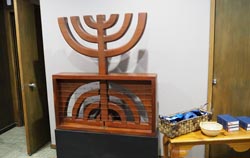
One piece in particular that Dr. Rushing really enjoys singing is the Kol Nidre, which is the opening prayer of Yom Kipper, the Day of Atonement and the holiest day in the Jewish calendar. He told a story about why it is sounded three times, at least according to a rabbi he was working with once:
A very beautiful prayer. The tradition is, it's still a tradition at this synagogue, it's that the Kol Nidre is iterated three times at the beginning of that service. You hear it three times in a row. In our congregation, you hear it played by the cello once. They speak it entirely and then the cantor sings it. Then one day I said, "Rabbi, what's the deal? Why do we say this three times? It's not biblical." I was making a joke. He told us that this was such an important prayer in Jewish tradition that the rabbis wanted to make sure that people heard it. So they had a problem. People didn't show up to service on time. So what they did is that they repeated it three times! To make sure that everybody got to hear it. I said, "You're kidding!" and he said, "No!" So you never know what's going to affect performance practice. . . . But this particular prayer was one that they absolutely [felt] was necessary that everybody heard it. So sometimes you'll hear it spoken three times or sung three times, depending on what the options are. But that's another really wonderful prayer. That's actually mostly in Aramaic but also some in Hebrew it's sung. (Rushing 2016)
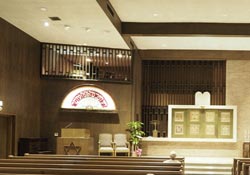
The placement of the cantor, or where the cantor sings, can also be determined by the Rabbi. At B'nai Israel, the cantor sings from a choir loft that is above and to the left of the bima, or the altar platform from where the rabbi addresses the congregation. This is a small space which is slightly screened-off, and barely contains the large organ in addition to the cantor. When sitting in the pews below, the sound of the cantor can seem otherworldly, as if a voice is coming from above, since it is difficult to see either the cantor or the organist. There are other times when Dr. Rushing has sung from the bima, in view of the congregation and sharing the lectern with the rabbi. The fact that Dr. Rushing is not Jewish and yet is the Cantor at B'nai Israel is not completely unusual, but it does present problems when trying to learn the work of cantor in more traditional institutional settings. Traditionally, the cantor would be trained in the same religious training as a rabbi, and would essentially be ordained a rabbi. Because of this, it is preferable for institutions that train cantors that their students be members of the Jewish faith. At B'nai Israel, Dr. Rushing took over cantorial duties in 2007 after spending several years as a hired soloist and member of the choir hired for the High Holy Days. The learning curve was intense as he had a lot of new music to learn and sing. Rabbi Barry Weinstein, the rabbi at the time, saw this and thought a summer course at Hebrew Union College in Cincinnati would help the new cantor get up to speed. Dr. Rushing explained what happened:
So I called Hebrew Union College the semester before and I explained who I was, and they kept asking me questions. "Are you the choir director?" I said, "No, I'm not the choir director." "Are you the organist?" "No, I'm not the organist." "Well, what do you do exactly?" "Well," I said, "Well I'm the cantorial soloist." And they said "Oh." They said, "Well, I hate to tell you but we don't allow non cantors or people who are not studying to be a cantor to come to our workshops. If you were a choir director or you were an organist, and you were not Jewish, it would be ok for you to come and take a workshop from us. Because what we do here is we train people to be cantors, we don't feel as though we should be training people who are not going to or opening this up to them." And I respected that. I mean, I questioned it first of all, just because that's what I would have done. I would have probably said, "No that's not the right thing." Because it is, I mean everything that a Rabbi can do a cantor can do. They are a Rabbi. They can just happen to have these extra skills in music. So, instead of me going to Union College, I actually went down to New Orleans and coached with Joel Coleman, Rabbi Joel Coleman, from one of the synagogues down there. That's when I really started to understand better the context of the music, what roles it played, the importance of certain moments. (Rushing 2016)
Baptist Church Music Director
Being a song leader involves singing, but it can also involve guiding the direction of music overall at the religious institution. That can mean not only choosing music to sing, but directing the choirs, coaching the musicians and leading the musical expression of worship for a congregation. At Greater New Guide Baptist Church, Antonio Rice, plays all the roles of a church music director: running rehearsals, choosing music, singing as a soloist, meeting with the Pastor and many other tasks. On a typical Sunday at the church, you will find Antonio leading both the choir and the congregation.
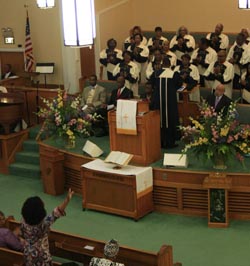
The repertoire at Greater New Guide places an emphasis on traditional Baptist congregational hymns, with occasional modern gospel choir songs interspersed throughout the service. These hymns are considered central to the mission of Greater New Guide, and are sung in a very deliberate and unison style. Pastor Isaiah Webster, the pastor for Greater New Guide, feels that congregational music is the best kind of music for his church because it removes the impulse for performance as entertainment and competition. But he also understands the value and history of choirs in the Black church tradition. He shared, "For several years, we didn't have a choir. We had congregational music. So that tells you how strongly I feel about that. . . . They talk about the Levities in the Old Testament, but think the choir as we understand it is kind of hard to find in the Bible!" (Webster 2016). Still, Pastor Webster felt that it was important to acknowledge that his congregation was interested in having a choir and he has made sure to keep a balance between the importance he places on hymn singing and the interests of his church in other styles of singing. Antonio himself commented that this hymn tradition was not one that he was familiar with from his own experience growing up in the church:
Greater New Guide sings hymns from the first stanza all the way to the last stanza. And maybe at home we'd sing the first verse and the chorus and repeat the chorus because we don't know the next verse. But . . . when I got here I was amazed because, actually the hymns tells a story, so if you leave a verse out, you're missing part of the story! So it makes sense to sing the whole story.
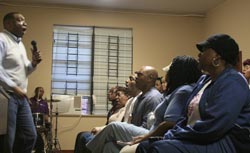
Antonio grew up in a small town in Northeast Mississippi, where his parents were both active members of different churches. His mother's church was similar to Greater New Guide in that they sang hymns, but his father's church, which he called his home church, was one that featured quartet singing. He and his sister used to "play church" at home as kids, where she would wear a choir robe as if she were a member of the choir and he would construct an imaginary piano out of a coffee table, with clothespins on the floor as piano pedals. He admired the pianists he heard in church and was particularly inspired by his piano teacher, Doris Cleveland, who played a more traditional style of music. Antonio was also influenced by the gospel music he heard on the radio. Listening to these radio programs, he became inspired to become a choir director, getting his first church pianist job in seventh grade. He played in a variety of churches, from Methodist to Baptist churches in and around Macon, Mississippi. Antonio learned on the job, by watching other choir directors, and through gospel music workshops. In college, he continued his music studies in choral music and gathered all of these experiences into how he approaches his current job as the music director at Greater New Guide.
The relationship between the pastor and the music director at Greater New Guide is one that guides the choice of music at the church. Antonio works in tandem with Pastor Webster, to shape the musical themes for each week. He explained the process like this:
It's enough for him [Pastor Webster] to give me this sheet, and he gives me the text where he's coming from and I read the text and I get a good understanding of the text and then I can select the song from there. Let me tell you something, if the spirit would give me songs before he gives me the text . . . like right now I don't have the music for the next quarter yet, but I'm already compiling songs because I kinda feel like I already know what direction he's going in. From where he's preaching from now, so. And sometimes I'll make the song lists without even looking at his sermons and [Snaps] it rolls just like that. I try to stay in tune with the spirit so I can know what I need to be ministering on Sunday. Sometimes we have to minister directly to people. Well, all the time we're ministering directly to people but sometimes there's something specific that the person needs and God will give me a song to minister to that person. Just like writing a sermon. Just like in a sermon, you have to have the right song for the right moment. (Rice 2016)
Antonio's approach to choosing songs is also influenced by the sense of continuity that he aims to achieve with the music during the service, or the sense of flow. As a music director, he is not only responsible for leading the musicians, but leading the congregation in worship through music. Flow is achieved when the music connects the congregation to the spirit of worship thereby unifying the church in their celebration. According to Antonio, the musicians have as much responsibility for the state of flow as he does:
The point is to keep everybody together and eliminate all distractions. If it gets quiet in church, it's easy to have a distraction going on. But if everybody is tuned to what's going on in front of them, then you can kind of keep everything together. Now, if the flow get off, it's going to be kind of up to the musicians to get the flow back on. Because the musicians are the ones that are actually working during the worship service. They've actually carried the worship service up until the point when it's time for the word of God to come forth. So, their responsibility in worship service is just as important as my responsibility as the choir director in worship service.
The importance of keeping the spirit moving in the right direction becomes one of the most important roles for a music director. And it is a theme that returns in other faith denominations, the efficacy of music in directing not only the congregation, but the spirit.
Worship Leaders in the Pentecostal Church
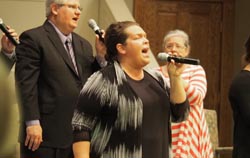
The First Pentecostal Church of Baton Rouge's repertoire is decidedly modern and current with popular music trends. But it is music that has for its main purpose the same function as old-time hymns: leading the congregation in praise and worship. On a recent Sunday, the Praise Team gathered to rehearse the songs for that day's service. A drummer, bassist, and keyboardist were in full rehearsal as the Praise Team members gradually arrived under threat of a massive thunderstorm. It was 8:30 am, and the service did not start until 11am, but there were several pieces to go through and then Sunday School to attend in-between, which meant rehearsal had to go smoothly. The vocalists each had their own wireless microphone and sang the songs, in parts, from memory. Their leader, Deidre Summers, played keyboards behind them, stopping the group every once and a while to review a harmony part, or discuss the sequence of the lyrics displayed by the overhead projector. After an hour of rehearsal, the musicians went to their Sunday School classrooms, returning by 10:45 in time for the service to begin.
Deidre Summers, the worship leader at First Pentecostal, noted that the music performed at the church is very modern, and different from more traditional Pentecostal churches, in both its style and presentation. Having a Praise Team, a group of 7-8 singers, instead of a choir is a more modern development for the church. And she takes repertoire inspiration not only from what is current in gospel music and Christian music trends, but also from what she hears in black gospel church choirs. On occasion, she will visit a Sunday evening service at specific black churches where she finds the music to be very inspiring. The demographic make-up of First Pentecostal is majority white, with a few African-American congregants. Still, Deidre feels that the spiritual drive of the music of the black gospel church fits well with the mission of the service at First Pentecostal. She described her approach to the group's musical repertoire this way:
We kind of know what our congregation is a little more drawn to, acceptant of, and we kind of try to stay within something that we know will work for a service. Because again, there are plenty of songs that I love that I listen to, but in my mind, if I'm looking for songs for church service, in my mind I'm listening to it going "Ok, I love this song, but how would this song work in a service?" And sometimes those are the songs that we take and slightly rearrange to make it work for us or for our service. Some of the stuff that's a little on the wilder side, like guitars and things like that, we can take and bring that down a little bit. Put more keys to it, a little less guitar, so it's not that a rock driving kind of sound. So, again, we are sort of particular about the songs, just knowing what will work for our assembly. (Summers 2016)
By having music of various modes, "wilder" or more reflective, the worship leader is tapping into the function of the music in the service.
In a typical Pentecostal service, music played and sung at the start of the service can be described as "Praise" music. It is of a fast tempo and energizing. This is music intended to encourage the congregation to come to worship and focus their attention on the meaning of their weekly gathering. The music shifts into "Worship" styles when it is felt that the congregation has moved to a more personal and direct relationship in their prayer. This shift is marked by slower music tempos, "pull at your heartstrings" music as Deidre describes it. The most important function of the music at that point is to sustain and support the membership in their direct worship. Sometimes, this can take the form of speaking in tongues or being overwhelmed by the power of their direct connection with God. And sometimes, the worship leader can feel that the congregation is moving in that direction before the music has, what Deidre calls "a God moment." Deidre explained what it is like for a music director when that happens:
Well, in the flesh we do the best that we can and we let God take over, honestly, because there are plenty of times when you're going "I'm really feeling this song but man, we didn't practice this song, you know, it's been a while since we did this song, but I'm really feeling this song, so!" So we'll kind of, you know it's one of those things that can only be described as a God moment. If God is telling you to do it and you know in your heart that this is where we need to go, you just make it happen. We have a platform guy that helps with leaps and you're just looking at him "Get this song out the book! Get this song out the book! Get it now! Get it now! I mean, like let's go on!" And everybody's scrambling, trying to rush and media's trying get the words loaded up in there and all that kind of stuff, so I mean, it happens. But I mean we just, we know when it happens that it's a God thing and it needs to happen, so we just make it work! (Summers 2016)
To be that flexible means that the Worship Leader and her musicians need to be in full command of their music. The Praise Team at First Pentecostal prepares each week by listening to the selected songs, sent to them in a Dropbox folder by Deidre, which they download and learn. None of the singers needs to read music and sheet music is not used in rehearsal by the singers. All learning of parts is done by rote and memory.
Deidre understands her role as Worship Leader for the church to be integral to the flow and success of the service. If the music is not moving the congregation into worship, then it is not fulfilling its role. She feels that her role is not just leading the congregation in song, but also leading the Praise Team so that they can help the congregation. The two are tied together in this way:
You're that go-between between the praise singers and that congregation to sometimes pull that congregation to you. And at the same time, you're pulling the Praise Team along with you too, to engage them in that worship. To engage them to, you know, set the atmosphere. Because that's what a Praise Team does, and as a worship leader, I take that very seriously. I'm not up there just to do a job. It's not about the performance. It is literally about a vertical worship. It is about engaging that congregation, bring them in, setting the atmosphere. Because that is what music is for, in the church, is to set the atmosphere for the word of God to come forth and to be preached. And music, you know when it's talked about in the Bible. The Bible talks about David, whenever Saul's heart was hardened, he would call for David to come and play, and that music would help to soften Saul's heart. And I think music, in the church especially, is just the best tool in order to soften people's hearts to be able to receive from the word of God. So as a worship leader, that is my number one goal, is to usher in the presence of God, let my worship and the worship we're trying to bring, to usher in the presence of God to let people's hearts be open so that they can receive what they need to receive from the word of God. (Summers 2016)
In the Pentecostal church, instrumental and vocal music is necessary for moving the spirit in the direction of vertical and personal worship. For other denominations, a cappella vocal music provides the most direct connection for their worship.
Songleaders in the Church of Christ
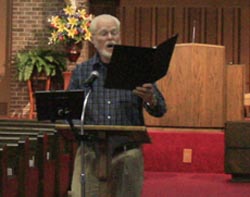
The Goodwood Church of Christ on Goodwood Boulevard holds two services on Sundays. The larger service, featuring a celebration of the Lord's Supper, happens in the morning, while a smaller group gathers in the early evening to sing, pray and reflect on the lesson taught by their minister, Joshua Fowler. The service begins with two hymns, sung a cappella and led by one of the male congregants of the church. The song leader stands at a lectern in the center of the main aisle, towards the back half of the church. Once the song title and number in the hymnal is announced, the congregation heads right into singing, with members choosing their own parts, bass lines, tenor, and alto parts rising up with confidence as the hymn moves from verse to verse. The music and lyrics are projected on the wall beside the altar using a program called "the Paperless Hymnal." Those who read music may notice something curious about the shape of some of the notes. Triangles instead of round note heads, some pointing in one direction, others in the opposite direction, occasionally followed by square notes. These shapes point back to a time when singing was taught within the Church of Christ by shape notes. And while there is no immediate memory of singing schools which taught the shapes at Goodwood, the congregation is familiar with it in a historical sense. What survives instead is active use of harmony singing by the congregation, which the shapes were originally used to help teach. Harmony is still important and present.
When asked about the importance of a cappella singing at Goodwood, the minister there, Joshua Fowler, recalled that singing has been an essential part of the church since its beginnings and that the congregation's approach to music reflects the church's founding:
The Church of Christ is part of a restoration movement. And the whole purpose of the restoration movement is to restore the church as closely as we can in the 21st century to what the First century church was like. One of the things the First century church did was sing a cappella. They probably didn't sing four part harmony, but they didn't use instruments. . . . As a restoration movement, that's one of the things that we have just kind of gone back to. It's a point of contention for a lot of folks, particularly in the a cappella tradition as we see some of our brothers moving away from that, it causes some strife. For me, it's all about heritage. It's a way that anchors me back into those early fathers of the church. And through the years, more recently my father, my grandfather, my great-grandfather that were part of the Churches of Christ and those men that have gone on before that honored that tradition, it's a way for me to connect with that heritage. And it separates what we do in church from a lot of the other music that is in our lives. That's the role that it plays for me and I think for a lot of folks that are in that tradition as well." (Fowler 2016)
The connection between the music of the past or the music in one's past and the present use of music is an important theme in how the congregation relates to the music sung at Goodwood Church of Christ. The majority of the hymns used in the service are very old, some dating back to the mid to late 19th century, with settings of important figures in Protestant hymnody like Isaac Watts, best known for the Christmas hymn, "Joy to the World." A popular hymn sung one Saturday evening service was "Softly and Tenderly," written in 1899 by William Thompson, with another song that evening, "I Come to the Garden Alone" dating back to 1913. The sentiments of the songs still hold deep meaning for the members of the church, no matter their age. Wesley Bradford, a Ph.D. student in Music Theory at LSU, often leads singing at services for Goodwood. He explained that while the bulk of the hymnal used in the Church of Christ does rely on these older hymns, newer hymns and songs are being composed and used in the services. Introducing new materials usually occurs first within youth groups, and then gradually those contemporary songs gain more usage throughout the church as the members grow in familiarity with the songs. Wesley, looking at the difference between newer and older songs, explained it from his perspective as a music theorist:
Sometimes I think that actually the harmony is simpler in some of the newer songs than some of the older songs. And sometimes the rhythm, especially verses what's on the page verses what we sing. A lot of times in the more contemporary songs, [it] is less clear cut. We'll have songs that I think, my own personal theory on what has happened is that, like you said, a lot of people learn them without having the music with them and they'll get really widespread and everybody will know kind of how they go, so to say, and somebody will be like, "Oh, by the way, here's the music for it too." And it doesn't always quite match up with how people know how it goes. And I feel like that's more of a thing with the more contemporary songs. Maybe a change in people not having as much musical education and less likely to read music now. I don't know if that's a statistic or not, but that's just kind of my own ideas." (Bradford 2016)
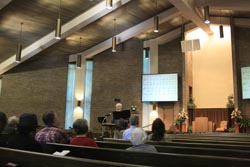
With a tradition rooted in a cappella singing, it makes sense that variations might occur from place to place as to how songs are sung. Still, these differences are seen as regional variations, and uniformity of interpretation is not strictly enforced. The job of the song leader for each church is choose which hymns will be sung at the service they are leading. They might confer with the minister to understand the theme of the lesson for that week, but most often the music is chosen because it is a familiar or favorite song for the song leader to lead. Only men may lead songs, and they agree to serve as one of the many service options available within the church. It is a volunteer position, not a paid church job. Wesley described his process for choosing songs as keeping in mind the flow of the service, choosing songs that move the congregation from one section of the service to the next. He commented:
For me when I'm selecting songs, sometimes we'll already have an idea of what the sermon is going to be about or the lesson is going to be about. Not always, but sometimes. And when I do know that, I try to keep that in mind when I'm selecting my songs and the songs are part of trying to kind of help create the mindset, create the mood. Like on Sunday mornings, we take communion every week and I try to choose songs that have something to do with," I'm trying to think about the cross and Christ or the Lord's s supper itself," And so I try to do that. And usually when I get up there, before the song that comes immediately prior to the communion I usually say something along the lines of "To help prepare ourselves for this element of the worship, we're going to sing this song." And you know, opening songs I try to think of usually something that is a little upbeat and different songs and like songs that, like before the prayer, "Sweet Hour of Prayer," or something to again, kind of help prepare for whatever is coming next. Also from a technical standpoint, again just trying to set some sort of at tempo that ideally people will follow, which is again not always as easy as you might think, a key, help sing the melody for people who might not know it. In most Churches of Christ, the song leaders are the only one who would be mic'd. And so, again that helps with people being able to pick up on the melody and follow even if you are sing the harmonies, to be able to hear relative pitches. (Bradford 2016)
The approach to musical styles and the role of the worship leader at Goodwood contrasted sharply with the other Protestant traditions in this study. Hymns, like at Greater New Guide, are an essential part of the service, and the maintenance of flow is necessary at all three protestant churches, from Pentecostal to Baptist to Church of Christ. However, stripped-down nature of the singing at Goodwood, and the absence of instrumentalists, means that the song leader is solely dependent on the congregation to move the spirit through music. Another shape note singing tradition in Baton Rouge also relies on the group as a whole for singing hymns, but instead in a secular context.



